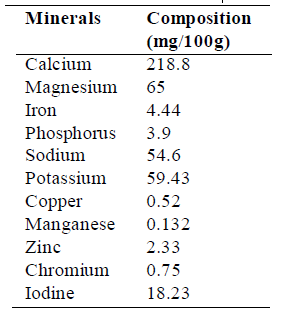Crab contains stomach-filling protein, which is utilised to create and repair body tissue. Crab is high in EPA and DHA, two anti-inflammatory long-chain omega-3 fatty acids. Research can help decrease blood pressure, prevent heart disease, boost cognitive function, and treat illnesses like psoriasis and ulcerative colitis. Minerals included in Crab, including copper, zinc, and selenium, help boost the immune system. This post examines the market analysis and proximate composition of several crabs and the health advantages.
Global Crab Market Research and Analysis
Crab contains stomach-filling protein, which is utilised to create and repair body tissue. Crab is high in EPA and DHA, two anti-inflammatory long-chain omega-3 fatty acids. Research can help decrease blood pressure, prevent heart disease, boost cognitive function, and treat illnesses like psoriasis and ulcerative colitis. Minerals included in Crab, including copper, zinc, and selenium, help boost the immune system. This post examines the market analysis and proximate composition of several crabs and the health advantages.
1. International trade
The crab market can develop by USD 3.02 billion between 2021 and 2025, with the market growing at a CAGR of 3.17 %.
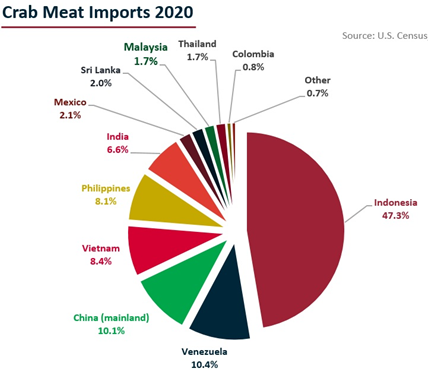
Crab imports (all sorts) fell from 1, 91,165 tons in the first half of 2019 to 1, 63,055 tons in the same time in 2020. (-14.7%). The major importer was the United States of America, which exhibited a small decrease in imports (-1.4 %). The Republic of Korea was the second-highest importer, with 26,569 tons compared to 27,043 tons during the same time in 2019. So yet, the COVID-19 scenario does not appear to be affecting total US crab imports. Imports were 59,343 tons in the first six months of 2020, compared to 60,201 tons in the same period of 2019. Crab shipments from Canada to the United States increased dramatically in the first half of 2020. A total of 14,845 tons were imported from Canada in June alone. Crab imports into China, on the other hand, fell by nearly 31% to 25,713 tons. All suppliers felt the decline. The Russian Federation was the greatest provider, although it sent 13% less than in the same time last year. Bangladesh was the second greatest provider, followed by the United States of America. China is the world’s largest market for live Crab, and this position is projected to be maintained in 2020. China and the rest of Asia are anticipated to absorb half of Russia’s live crab exports.
In the first half of 2020, the Republic of Korea imported 3,339 tons of live king crab. The Russian Federation was the most crucial provider, accounting for more than 90% of the total. The Republic of Korea is a chief importer of live Norwegian king crab. The Norwegian Crab has a little higher price of USD 39.78 per kilogramme than the Russian Crab, which fetches USD 35.27 per kilogramme (prices for June 2020). Although the Japanese market has slowed in recent years, imports of frozen king crab grew to 1,202 tons in the first half of 2020, up from 1,046 tons in the same time in 2019. The cost of frozen king crab has also increased. Snow crab imports from Japan, on the other hand, fell by 26% to 9,362 tons. Russian exports fell by 13.5 % to 26,796 tons in the first half of the year. Republic of Kore accounting for more than two-thirds of the total volume of the market.
Swimming crab imports to the United States totalled 11,386 tonnes in the first six months of 2020, down just 7% from the same period last year. Indonesia was responsible for 53% of the total, or 6,077 tonnes. Swimming crab landings typically peak during the rainy season, which finished in July, so supplies from Indonesia are projected to drop between the summer and the New Year. Production isn’t projected to rise again until January, when the next rainy season begins. Thus increasing supplies won’t hit the market until February 2021. It is anticipated that prices will rise.
2. Crabs in India
The Portunidae family includes the majority of edible crabs found in marine and brackish water habitats. Podopthalmidae (Borradaile), catoptrinae (Sakai), portuninae (Rafinesque), caphyrinae (Alcock), Carcininae (Macleay), and Polybinnae are the subfamilies of the Portunidae family that live in the Indian Ocean (ortmann). The protuminae subfamily is home to the majority of edible crabs found in marine and brackishwater habitats. Various authors have documented the presence of five genera of portuninae in the waters near India. Scylla, Portunus, Charybdis, Lupocyclus, and Thalamita are the names of the five mythical creatures. Portunus pelagicus (blue swimmer crab), Scylla spp. (mud crabs), P. Sanguinolentus (three-spotted Crab), Charybdis feriatus (Crucifix crab), c.lucifera (yellowish-brown Crab), C.Natator (line crab), and podophthalmus vigil (line crab) are the first three genera that contribute to the commercial crab fishery (long eye- stalk Crab; sub fly. podopthalmidae).
Species distribution along the Indian Coast [1]
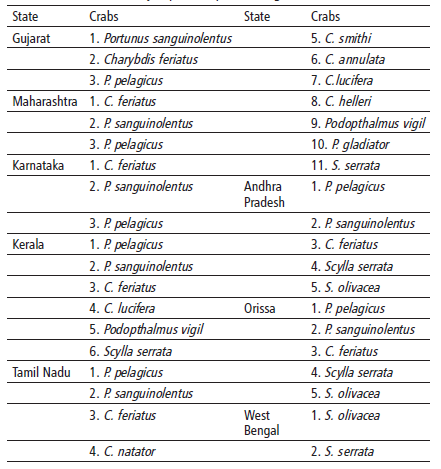
3. Proximate composition
i) Brachyuran crabs
Table 1. Brachyuran Crabs of proximate composition (%) [2]

ii) Portunus pelagicus (blue swimming crab)
Table 2. Crude protein, crude fat, crude fibre, ash, and total solids composition of p.pelagicus crab meals (75g) [3]
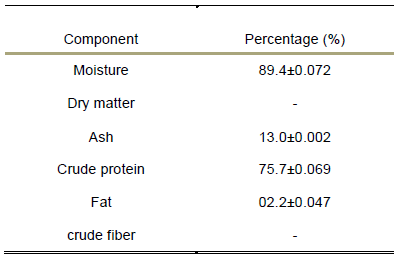
iii) Cooked Female Chaceon Maritae
Table 3. The edible tissues of boiled C. maritae were analysed for composition (g/100 g wet weight) and energy value (kcal/100 g) [4].

iv) Swimming Crab Portunus sanguinolentus
Table 4. Biochemical composition of Portunus Sanguinolentus [5]
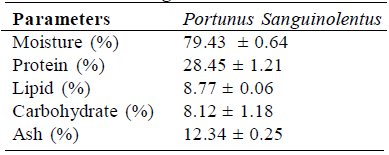
V) Jonah crab
At FRL, we’ll distinguish your nutritional bar as:
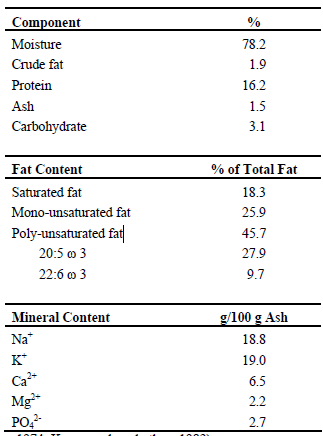
4. Health benefits of eating crab meat
All shellfish, including Crab, contain a high level of selenium. Selenium is an antioxidant that counteracts the carcinogenic effects of cadmium, mercury, and arsenic, all known to induce cancers in humans. Higher levels of selenium in the blood have been linked to a decreased risk of cancer. In reality, lysate, taken from the horse-shoe Crab’s blue blood, is utilised to identify spinal meningitis and combat cancer. [6]
i) Cholesterol
While crab meat has low saturated fat content, chromium in the flesh helps raise HDL (good cholesterol) levels in the body, lowering the risk of strokes, coronary, and circulatory heart disease. Crabs, in reality, contain sterol, which inhibits the absorption of other cholesterol consumed during a meal, therefore negating the adverse effects of other fats consumed.[7]
ii) Omega 3 fatty acids
All shellfish, including crabs, are high in omega-3 fatty acids. The crabs obtain these from phytoplanktons and algae, which are an essential element of their diet. People benefit greatly from omega-3 fatty acids because they assist in reducing the stickiness of blood platelets, making red blood cells more flexible and ensuring a smoother flow. Tri-glycerides and LDL (low-density lipoproteins), which clog arterial walls as deposits, are likewise reduced by omega-3 acids.
iii) Protein
Crab is one of the most significant protein sources accessible in the diet. It has about the same amount of protein per 100 grams as meat, but none saturated fat, linked to an increased risk of heart disease. Because Crab lacks connective tissue, its protein is good quality and easily digested by persons of all ages.
iv) Selenium
Selenium is abundant in all shellfish, but crab flesh is exceptionally high in it. Selenium is an essential part of the human antioxidant defence system, protecting cells and tissues from damage. Selenium is also vital for immune system function, thyroid hormone metabolism, and reproduction hormone synthesis. For males, 100g of crab flesh contains 112% of the required daily intake, while it gives 140% of the daily recommended amount for women.[8]
v) Riboflavin (vitamin B2)
Vitamins must be received through our diet, such as crab meat because they are water-soluble and cannot be stored in the body. Riboflavin (Vitamin B2) is necessary for creating steroid hormones and red blood cells and normal development and the health of the skin, eyes, and neurological system. Riboflavin also aids iron absorption in the gastrointestinal system and promotes antioxidant activity. Riboflavin turnover in the human body is considered to be linked to energy expenditure. Therefore physically active persons may have a higher need for Riboflavin in their diet.
vi) Copper and phosphorus
The copper content in crab flesh is about 30 times that of cod and 56 times that of salmon, chicken, and beef. Although iron receives the majority of the focus, copper is involved in iron absorption, storage, and metabolism. It aids in creating red blood cells and maintains the integrity of bones, blood vessels, neurons, and the immune system. Phosphorus is the body’s second most prevalent mineral, behind calcium. It is a significant component of bones and teeth and plays a vital role in skeletal health and development. Phosphorus is involved in nearly every metabolic process in the body, including kidney function, cell proliferation, and heart muscle contraction. It also plays a role in the conversion of food into energy.
Conclusion
Fishery produces 73.5 % of the crabs marketed worldwide, and there is little indication that fisheries populations can tolerate considerable increases in catch quantities. Climate change, overfishing, pollution, and habitat destruction, on the other hand, are likely to drastically diminish the supply of animals in the following years or decades. In most nations, aquaculture, on the other hand, is still a long way from being a feasible alternative for ensuring the long-term viability of this productive chain. The growth of aquaculture based on caught juveniles or intermolt animals may also strain wild populations. Crab hatchery and rearing technology are still in their infancy, making industrial-scale development difficult. High production costs and accompanying hazards (such as the newly revealed highly pathogenic reovirus) are all factors restricting aquaculture development, putting it in an adverse position to compete with fishing. By conducting studies on the fisheries’ biology of commercially exploited populations, developing less predatory practises and more selective fishing gears, and reducing the impacts associated with bycatch, fisheries companies, research institutions, funding, and regulatory agencies are critical agencies work together. The key issues in aquaculture include improving productivity through larviculture techniques, focusing on reducing losses due to cannibalism, feeding larvae and juveniles, reducing viral disease effects, and advancing the cultivation systems’ technological advancement.

Let’s create something Innovative and Delicious together
Food Research Lab strives for excellence in new Food, Beverage and Nutraceutical Product Research and Development by offering cutting edge scientific analysis and expertise.

